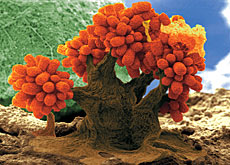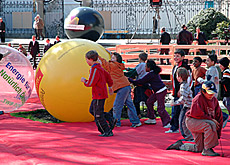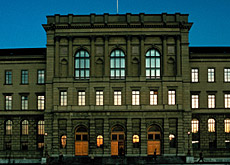Festival brings science to the people

Science is heading out of the laboratories and onto the streets of Switzerland’s towns and cities over the next two weeks.
More than 500 events are set to take place across the country as part of the second Science and City Festival.
Festival organisers stressed that the demonstrations, talks and interactive presentations would not repeat the mistakes made during the first event in 2001, which was criticised in part for being too academic and not accessible enough to the public.
“We are organising a celebration [of science] and not an elitist programme of events,” said Christine Beerli, president of the foundation which is organising the programme.
This year’s festival is being held to coincide with Brain Week, an annual opportunity for members of the public to meet scientists involved in brain research and to hear lectures and take part in debates with experts who are normally hidden away in quiet corners of hospitals, laboratories and research centres.
As part of an attempt to prove that science is for the masses and not just for white-coated professors, organisers have come up with a two-week programme which includes round-table discussions, films, theatre, music and dance performances.
The art of science
The lion’s share of the events, which include art exhibitions as well as talks on a wide range of scientific issues, are taking place in French-speaking Switzerland.
But cities elsewhere in the country, such as Zurich, Basel, Lucerne and Lugano, will also host exhibitions and demonstrations.
Beerli hopes the festival will help to build bridges between the worlds of science and culture and show that the two are not mutually exclusive but can learn and benefit from each other.
Andres Janser, the curator of an exhibition in Zurich entitled Simply Complex – Picture-Trees and Tree Pictures in Science, believes there is a willingness on the part of the scientific community to learn from artists and designers.
“Over the past few decades it has become increasingly important for scientists to work with pictures,” Janser told swissinfo.
“And art has a huge repertoire of answers to the question of how you go about developing and using images.”
Meeting of minds
One of the highlights of this year’s festival is a one-day “scientific café” in the western Swiss city of Lausanne.
On May 26 members of the public will have the chance to meet and put questions to Switzerland’s top government advisor on scientific matters: the country’s state secretary for science and research, Charles Kleiber.
Organisers expect around 100,000 people to attend this year’s festival – far fewer than turned out four years ago.
Exhibition managers say the anticipated fall in numbers can be explained by the fact that the budget for the event has been cut in half since the first edition.
This year’s Science and City Festival has a budget of SFr4.8 million ($3.89 million), with part of the money coming from the Federal Culture Office and the Arts Council of Switzerland.
swissinfo with agencies
The first Science and City Festival, staged in 2001, came in for criticism in some quarters for being too academic.
This year’s festival, which runs until June 5, includes more than 500 events across the country.
The budget is SFr4.8 million, roughly half the amount of money invested in a similar programme of activities four years ago.

In compliance with the JTI standards
More: SWI swissinfo.ch certified by the Journalism Trust Initiative


You can find an overview of ongoing debates with our journalists here . Please join us!
If you want to start a conversation about a topic raised in this article or want to report factual errors, email us at english@swissinfo.ch.